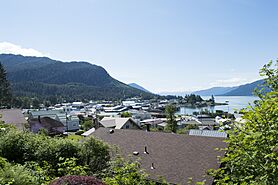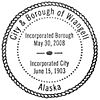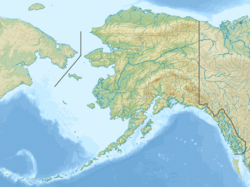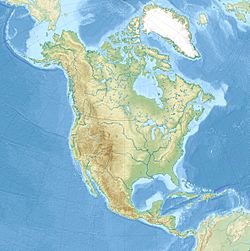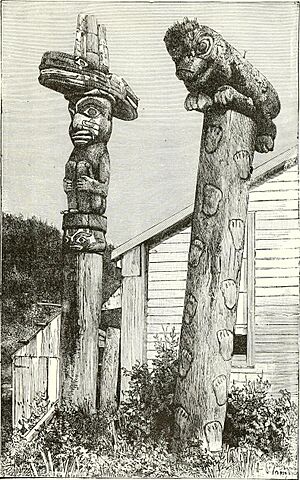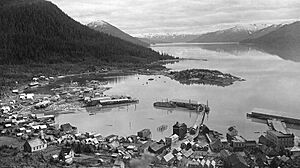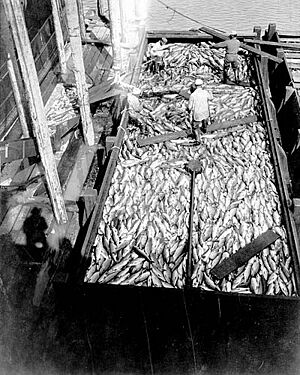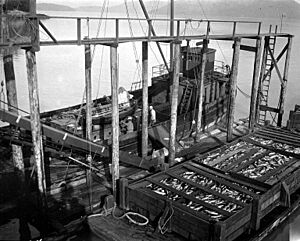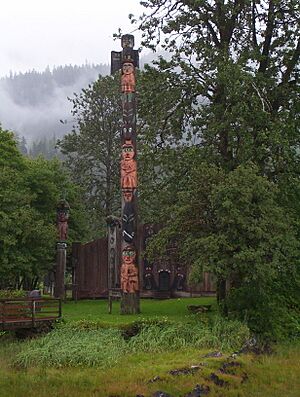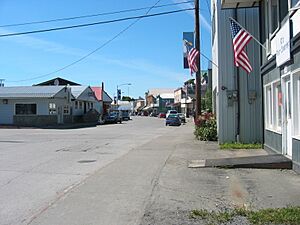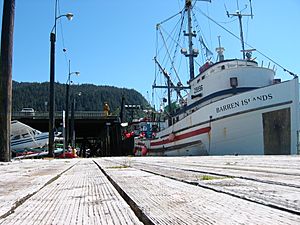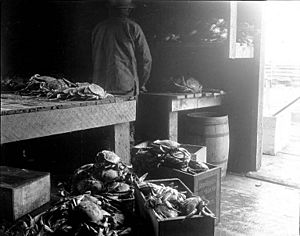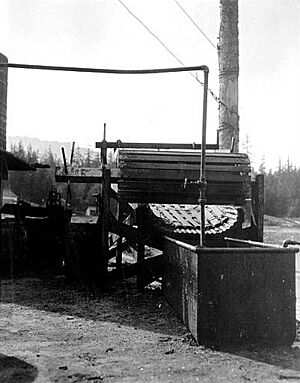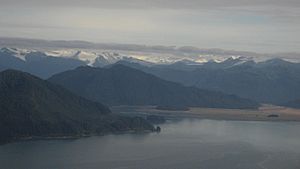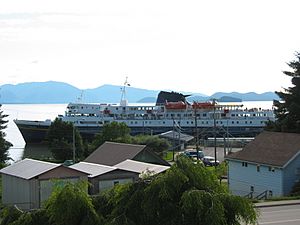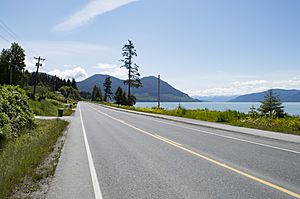Wrangell, Alaska facts for kids
Quick facts for kids
Wrangell, Alaska
Ḵaachx̱ana.áakʼw
|
|||
|---|---|---|---|
|
Unified Borough
|
|||
|
View of the city in 2016
Stikine River delta
Shakes Glacier in the Stikine-LeConte Wilderness
Fishing boat docked at harbor
Post Office and Customs House
Ferry M/V Stikine arriving
|
|||
|
|||
| Country | |||
| State | |||
| Founded | 1834 | ||
| English | 1839 | ||
| American | 1867 | ||
| Incorporated | 1903 (as a city); May 30, 2008 (as a borough) | ||
| Named for | Ferdinand von Wrangel | ||
| Area | |||
| • Unified Borough | 3,476.61 sq mi (9,004.37 km2) | ||
| • Land | 2,555.99 sq mi (6,620.00 km2) | ||
| • Water | 920.61 sq mi (2,384.38 km2) | ||
| • Urban | 71 sq mi (180 km2) | ||
| Elevation | 69 ft (21 m) | ||
| Population
(2020)
|
|||
| • Unified Borough | 2,070 | ||
| • Density | 0.83/sq mi (0.32/km2) | ||
| Time zone | UTC-9 (AKST) | ||
| • Summer (DST) | UTC-8 (AKDT) | ||
| ZIP code |
99929
|
||
| Area code(s) | 907 | ||
| FIPS codes | 02-275, 02-86380 | ||
| GNIS feature IDs | 1415843, 2418874 | ||
Wrangell is a special kind of county in Alaska, United States. It's called a borough. In 2020, about 2,127 people lived there. Wrangell used to be just a city. But on May 30, 2008, it became a "Unified Home Rule Borough." This means it's both a city and a county at the same time.
The local Tlingit people have a name for Wrangell: Ḵaachx̱ana.áakʼw. This means "Ḵaachx̱an's Little Lake." The Tlingit people who lived here for thousands of years call themselves the Shtaxʼhéen Ḵwáan. This name comes from the nearby Stikine River. Wrangell is located on the northwest side of Wrangell Island.
Contents
Exploring Wrangell's Past
The Tlingit people have lived on Wrangell Island for thousands of years. Their stories say they moved down the Stikine River long ago. They settled in many places along the river and coast. You can still see signs of their long history. Many ancient rock carvings, called petroglyphs, are found at Petroglyph Beach State Historic Park. This park is just north of Wrangell.
The area where Wrangell Harbor is now was called Ḵaachx̱ana.áakʼw by the Tlingit. It means "Ḵaachx̱an's little lake." This is because the harbor entrance would sometimes dry up at low tide. Ḵaachx̱an was a man who lived in a smokehouse by this "little lake."
Wrangell in the 1800s
Wrangell is one of the oldest towns in Alaska that was not built by Native people. Russian traders came here in 1811 to trade for furs with the Tlingit. In 1834, the Russians built a fort called Redoubt Saint Dionysius. This fort was near where Wrangell is today.
In 1839, a British company called the Hudson's Bay Company took over the fort. They renamed it Fort Stikine. The Tlingit people were not happy that the British used their trade routes. Sadly, two smallpox outbreaks in 1836 and 1840 greatly reduced the Tlingit population. This made it harder for them to protest.
The British left the fort in 1849 because there were not many furs left to trade. In 1867, the United States bought Alaska. In 1868, the U.S. Army built a military post called Fort Wrangell here. It stayed open until 1877.
The town grew as people came for the gold rushes in 1861, 1874, and 1897. Many businesses, like gambling halls and bars, opened to serve the miners. Thousands of miners passed through Wrangell on their way to find gold.
In 1877, the first Protestant church in Alaska was built in Wrangell. A minister named S. Hall Young came to work with the miners and Tlingit people. He started a school to teach young Tlingit men different skills.
S. Hall Young was friends with John Muir, a famous naturalist. Muir lived in Wrangell from 1879 to 1880. They explored many places in Southeast Alaska together. Wrangell is special because it has been ruled by four different groups: the Tlingit, Russians, British, and Americans.
Wrangell in the 1900s
In the late 1890s, large fish traps were built near the Stikine River. These traps helped the fishing and fish canning businesses grow in Wrangell. Fishing was very important to the town's economy. However, these traps also hurt the salmon population in the Stikine River. After Alaska became a state, the fish traps were removed. Fishing is still a main job for many people in Wrangell today.
The local newspaper, The Wrangell Sentinel, started in 1902. It is the oldest newspaper in Alaska that has been printed without stopping.
A famous store called the Bear Totem Store opened in the 1920s. It had many beautiful Tlingit artworks and totem poles. But a big fire in the 1950s destroyed much of downtown Wrangell, including the store. Many old buildings were lost.
Today, the main jobs in Wrangell are logging, fishing, and tourism. The Wrangell Cooperative Association is a Tlingit group that helps take care of Chief Shakes Tribal House. This house is a copy of a traditional Tlingit home. It was built in the 1930s on Shakes Island in Wrangell harbor.
Wrangell in the 2000s
In 2008, the people of Wrangell voted to change their city status. They wanted to become a borough, which is like a county. On May 30, 2008, Wrangell officially became the City and Borough of Wrangell.
The Wrangell Cooperative Association is working to fix up Chief Shakes House and the totem poles. They have a master carver and a team helping them.
Wrangell's Location and Surroundings
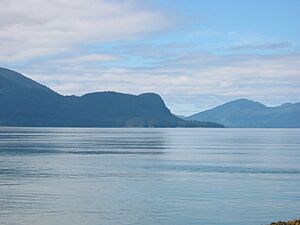
Wrangell is located on the northern tip of Wrangell Island. This island is in the Alaska Panhandle, which is the southeastern part of Alaska. Wrangell is about 155 miles (249 km) south of Juneau, Alaska's capital. It sits across a narrow water channel from the mouth of the Stikine River. The town and island are named after Ferdinand Petrovich Wrangel, a Russian explorer.
The borough of Wrangell covers a large area. Most of it is land, but a good portion is water. It includes the eastern half of what used to be the Wrangell-Petersburg Census Area.
Nearby Areas
Wrangell shares borders with other areas:
- Petersburg Borough, Alaska
- Prince of Wales–Hyder Census Area, Alaska
- Ketchikan Gateway Borough, Alaska
- Regional District of Kitimat–Stikine, in British Columbia, Canada (to the east)
Wrangell's Weather
Wrangell has an oceanic climate. This means it has mild, rainy summers with cool nights. Winters are cold, but not as cold as some other parts of Alaska.
| Climate data for Wrangell, Alaska (1991–2020 normals, extremes 1917–present) | |||||||||||||
|---|---|---|---|---|---|---|---|---|---|---|---|---|---|
| Month | Jan | Feb | Mar | Apr | May | Jun | Jul | Aug | Sep | Oct | Nov | Dec | Year |
| Record high °F (°C) | 62 (17) |
65 (18) |
61 (16) |
77 (25) |
86 (30) |
91 (33) |
92 (33) |
85 (29) |
82 (28) |
72 (22) |
66 (19) |
60 (16) |
92 (33) |
| Mean maximum °F (°C) | 49.0 (9.4) |
48.7 (9.3) |
51.9 (11.1) |
62.0 (16.7) |
69.6 (20.9) |
76.2 (24.6) |
74.8 (23.8) |
74.8 (23.8) |
65.3 (18.5) |
58.3 (14.6) |
50.5 (10.3) |
49.0 (9.4) |
79.2 (26.2) |
| Mean daily maximum °F (°C) | 36.3 (2.4) |
38.5 (3.6) |
42.3 (5.7) |
49.5 (9.7) |
57.9 (14.4) |
61.2 (16.2) |
63.7 (17.6) |
63.3 (17.4) |
57.5 (14.2) |
49.2 (9.6) |
41.2 (5.1) |
37.3 (2.9) |
49.8 (9.9) |
| Daily mean °F (°C) | 32.5 (0.3) |
34.3 (1.3) |
37.3 (2.9) |
43.4 (6.3) |
50.8 (10.4) |
55.3 (12.9) |
58.0 (14.4) |
57.5 (14.2) |
52.7 (11.5) |
45.2 (7.3) |
37.8 (3.2) |
33.9 (1.1) |
44.9 (7.2) |
| Mean daily minimum °F (°C) | 28.8 (−1.8) |
30.1 (−1.1) |
32.3 (0.2) |
37.4 (3.0) |
43.7 (6.5) |
49.3 (9.6) |
52.2 (11.2) |
51.8 (11.0) |
47.9 (8.8) |
41.3 (5.2) |
34.5 (1.4) |
30.5 (−0.8) |
40.0 (4.4) |
| Mean minimum °F (°C) | 11.3 (−11.5) |
17.2 (−8.2) |
20.3 (−6.5) |
28.8 (−1.8) |
35.5 (1.9) |
42.3 (5.7) |
46.7 (8.2) |
45.8 (7.7) |
39.3 (4.1) |
31.1 (−0.5) |
23.5 (−4.7) |
17.8 (−7.9) |
7.1 (−13.8) |
| Record low °F (°C) | −10 (−23) |
−8 (−22) |
0 (−18) |
16 (−9) |
22 (−6) |
30 (−1) |
32 (0) |
31 (−1) |
22 (−6) |
18 (−8) |
1 (−17) |
−7 (−22) |
−10 (−23) |
| Average precipitation inches (mm) | 8.01 (203) |
6.13 (156) |
6.09 (155) |
4.94 (125) |
4.79 (122) |
4.29 (109) |
5.36 (136) |
6.99 (178) |
11.49 (292) |
13.91 (353) |
10.01 (254) |
9.20 (234) |
91.21 (2,317) |
| Average snowfall inches (cm) | 18.4 (47) |
12.4 (31) |
7.9 (20) |
0.8 (2.0) |
0.0 (0.0) |
0.0 (0.0) |
0.0 (0.0) |
0.0 (0.0) |
0.0 (0.0) |
0.1 (0.25) |
5.8 (15) |
12.6 (32) |
58.0 (147) |
| Source 1: NOAA (Precipitation 1981–2010) | |||||||||||||
| Source 2: WRCC | |||||||||||||
Protected Natural Areas
Part of the Tongass National Forest is near Wrangell. This includes:
- South Etolin Wilderness
- Part of the Stikine-LeConte Wilderness
Wrangell's Economy and Jobs
The main job in Wrangell is fishing. Many people work on commercial fishing boats. There are also guides who take tourists on sports fishing trips. These trips go to places like the Stikine River. Boat repair shops have grown to fix larger boats.
Wrangell also has a golf course with a view of Mount Wrangell. The government helps the local economy with spending from the forest service and postal service.
Whales visit the waters around Wrangell to find food. This creates great chances for photos. Logging used to be a big industry, but the large sawmills closed in the 1990s.
Wrangell has three marinas for boats. The one at Shoemaker Bay is being rebuilt. A Tlingit cultural center and museum is located by the water.
Wrangell has daily flights from Alaska Airlines to Seattle and other Alaskan cities. The Alaska Marine Highway ferry system also stops in Wrangell. This connects the town to other parts of Southeast Alaska.
Wrangell has several churches, bars, and a pizza place. The local Native Corporation helps pay for health care. You can also go on guided kayak tours in the summer. Wrangell is a great place for hiking, camping, and climbing in the forest.
Wrangell's Population Over Time
| Historical population | |||
|---|---|---|---|
| Census | Pop. | %± | |
| 1880 | 106 | — | |
| 1890 | 316 | 198.1% | |
| 1900 | 868 | 174.7% | |
| 1910 | 743 | −14.4% | |
| 1920 | 821 | 10.5% | |
| 1930 | 948 | 15.5% | |
| 1940 | 1,162 | 22.6% | |
| 1950 | 1,263 | 8.7% | |
| 1960 | 1,315 | 4.1% | |
| 1970 | 2,029 | 54.3% | |
| 1980 | 2,184 | 7.6% | |
| 1990 | 2,479 | 13.5% | |
| 2000 | 2,308 | −6.9% | |
| 2010 | 2,369 | 2.6% | |
| 2020 | 2,127 | −10.2% | |
| 2023 (est.) | 2,064 | −12.9% | |
| U.S. Decennial Census | |||
Wrangell first appeared on the U.S. Census in 1880. At that time, 106 people lived there. By 1890, the population grew to 316. Most of these people were Native Alaskans. In 1903, Wrangell officially became a city. Its population continued to grow over the years. In 2008, Wrangell became a city and borough.
Wrangell's Schools
Wrangell is part of the Wrangell Public Schools system. It has:
- Evergreen Elementary School
- Stikine Middle School
- Wrangell High School
The Wrangell Institute was a boarding school for Alaska Natives. It opened in 1932 and closed in 1975.
Wrangell's Post Office
In 1943, artists Austin Mecklem and Marianne Greer Appel painted a mural for the Wrangell post office. It was called Old Town in Alaska. The painting was finished in New York and brought to Wrangell. It was put up in the post office in early 1944.
Wrangell's Media
Newspaper
The Wrangell Sentinel is the local newspaper. It has been printed since 1902. It is the oldest newspaper in Alaska that has been published without stopping.
Library
The main library in Wrangell is the Irene Ingle Public Library. You can find more information at wrangell.com/library.
Radio
Wrangell has two radio stations:
- KSTK plays Public Radio programs.
- KWRG-LP plays Christian programs.
Getting Around Wrangell
On Wrangell Island, you can travel by ferry or airplane. The island has paved roads and many logging trails.
Ferry Travel
The Alaska Marine Highway ferry system serves Wrangell. It has regular stops that connect people to other towns in Southeast Alaska.
The Inter-Island Ferry Authority also has a ferry, the M/V Stikine. It travels between Coffman Cove, Wrangell, Petersburg, and Ketchikan.
Airport Travel
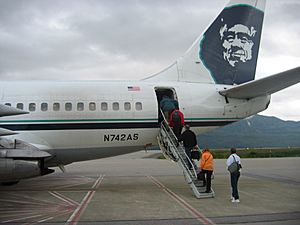
Alaska Airlines has two daily flights using Boeing 737 planes. One plane arrives in the morning, and one in the evening. Sunrise Aviation offers float plane services to the area.
Roads in Wrangell
The main road is the Zimovia Highway. It runs along the west side of the island for 14 miles (22 km). Most other roads in the area are unpaved logging trails or forest service roads. Isheyama Drive is paved for two miles south of the golf course.
See also
 In Spanish: Wrangell para niños
In Spanish: Wrangell para niños


